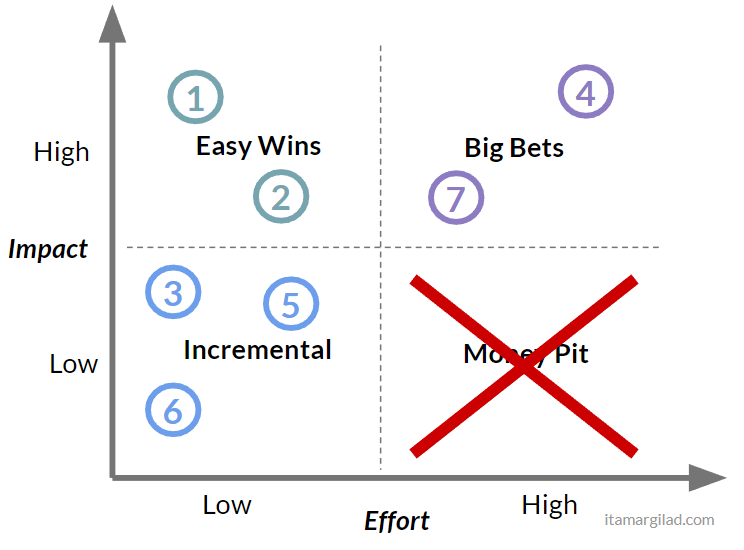Impact vs. Effort Matrix: How You Can Apply It

Ruben Buijs
The Impact vs. Effort Matrix is a decision-making tool used in Saas product management to prioritize tasks, features, or projects based on their potential impact and the effort required to implement them. It helps product managers make informed decisions by visually assessing the value of different initiatives and allocating resources accordingly.
Importance
The Effort Impact Matrix is essential for effective product management as it enables teams to focus on high-impact, low-effort tasks first, maximizing productivity and delivering value to customers. By categorizing potential initiatives into quadrants, product managers can prioritize their efforts, allocate resources efficiently, and ensure that the most impactful projects receive the attention they deserve.
How to Use It
To utilize the Impact Effort Matrix effectively, follow these steps:
- Identify potential initiatives: Begin by brainstorming and compiling a list of tasks, features, or projects that need prioritization.
- Determine impact: Assess the potential impact of each initiative on your Saas product. Consider factors such as customer satisfaction, revenue growth, market share, or strategic alignment.
- Evaluate effort: Evaluate the effort required to implement each initiative. This assessment should take into account factors like development time, resources required, and complexity.
- Plot initiatives: Plot each initiative on the matrix based on its impact and effort. Typically, a matrix with four quadrants is used: high impact, low effort (quick wins), high impact, high effort (major projects), low impact, low effort (low priority), and low impact, high effort (consider avoiding).
- Prioritize and plan: Prioritize initiatives based on their position in the matrix. Focus on quick wins and major projects, and consider deprioritizing or eliminating initiatives in the low impact, high effort quadrant.
- Review and update: Regularly review and update the Impact vs. Effort Matrix as priorities, resources, and market conditions change.
Useful Tips
- Engage stakeholders: Involve relevant stakeholders, such as development teams, marketing, and customer support, when assessing impact and effort. This ensures a holistic view and helps in making informed decisions.
- Iterate and refine: The matrix is not a one-time exercise. Continuously refine and update it as new initiatives arise, and reassess the impact and effort of existing ones.
- Consider dependencies: Take into account dependencies between initiatives when plotting them on the matrix. This helps in understanding the potential impact and effort accurately.
Related Terms
- Prioritization techniques
- Product roadmap
- Minimum Viable Product (MVP)
- User feedback analysis
- Kanban board
- Agile development
- Risk vs. Reward analysis
- Customer segmentation
- Competitive analysis

